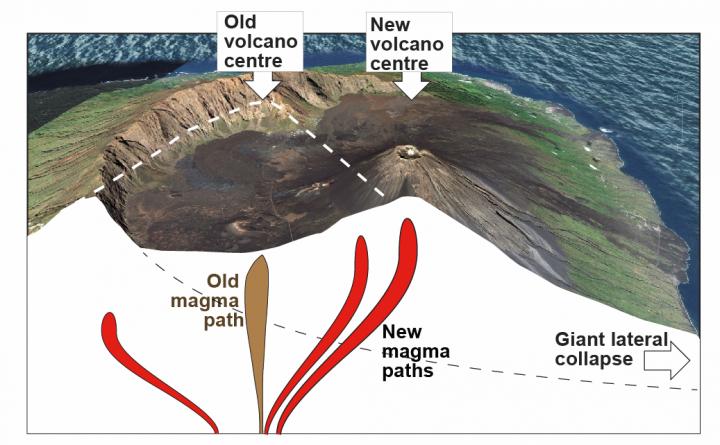New magma pathways after giant lateral volcano collapses

Giant lateral volcano collapses affects the deep paths of magma. This process can be seen at Fogo Volcano, Cabo Verde. Credit: Fig. GFZ/Walter
Giant lateral collapses may change the style of volcanism and the chemistry of magma, and as a new study by GFZ scientists reveals, also affects and diverges the deep paths of magmas.
New volcano centres may form at other places, which the scientists explain by studying the stress field changes associated with the lateral collapse.
In the study entitled “The effect of giant lateral collapses on magma pathways and the location of volcanism”, authored by F. Maccaferri, N. Richter and T. Walter, all working at GFZ, in section 2.1 (Physics of earthquakes and volcanoes), the propagation path of magmatic intrusions underneath a volcanic edifice has been simulated by means of a mathematical model.
Computer simulations revealed that the mechanical effect on the earth crust resulting from a large lateral collapse, can promote the deflection of deep magmatic intrusions, favouring the formation of a new eruptive centre within the collapse embayment.
This result has been quantitatively validated against observations at Fogo Volcano, Cabo Verde.
A broader view to other regions reveals that this shift of volcanism associated with giant lateral collapses is rather common, as observed at several of the Canary Islands, Hawaii, Stromboli and elsewhere.
This study may have implications particularly for our understanding of the long term evolution of intraplate volcanic ocean islands and sheds lights on the interacting processes occurring during growth and collapse of volcanic edifices.
Media Contact
All latest news from the category: Earth Sciences
Earth Sciences (also referred to as Geosciences), which deals with basic issues surrounding our planet, plays a vital role in the area of energy and raw materials supply.
Earth Sciences comprises subjects such as geology, geography, geological informatics, paleontology, mineralogy, petrography, crystallography, geophysics, geodesy, glaciology, cartography, photogrammetry, meteorology and seismology, early-warning systems, earthquake research and polar research.
Newest articles

NASA: Mystery of life’s handedness deepens
The mystery of why life uses molecules with specific orientations has deepened with a NASA-funded discovery that RNA — a key molecule thought to have potentially held the instructions for…

What are the effects of historic lithium mining on water quality?
Study reveals low levels of common contaminants but high levels of other elements in waters associated with an abandoned lithium mine. Lithium ore and mining waste from a historic lithium…

Quantum-inspired design boosts efficiency of heat-to-electricity conversion
Rice engineers take unconventional route to improving thermophotovoltaic systems. Researchers at Rice University have found a new way to improve a key element of thermophotovoltaic (TPV) systems, which convert heat…



